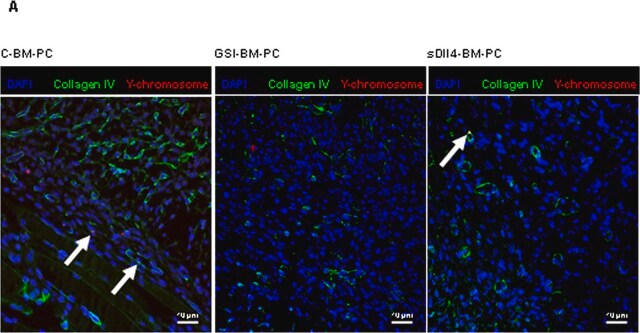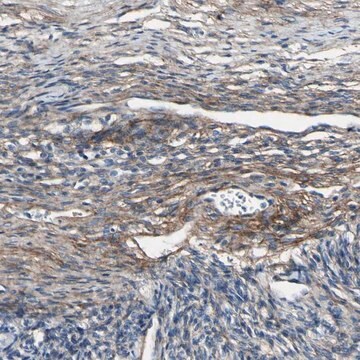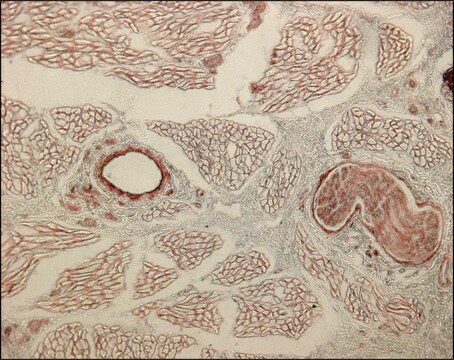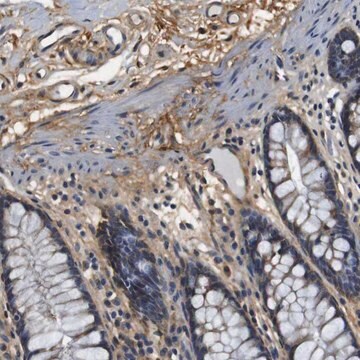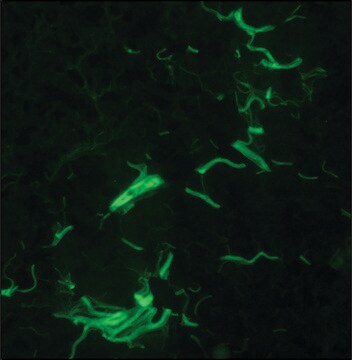MAB1944
Anti-Collagen Type VI Antibody, clone 3C4
ascites fluid, clone 3C4, Chemicon®
Sinonimo/i:
Collagen alpha-3(VI) chain, Collagen VI alpha-3 polypeptide
About This Item
Prodotti consigliati
Origine biologica
mouse
Livello qualitativo
Forma dell’anticorpo
ascites fluid
Tipo di anticorpo
primary antibodies
Clone
3C4, monoclonal
Reattività contro le specie
human
Produttore/marchio commerciale
Chemicon®
tecniche
electron microscopy: suitable
flow cytometry: suitable
immunocytochemistry: suitable
immunohistochemistry: suitable (paraffin)
immunoprecipitation (IP): suitable
Isotipo
IgG1κ
N° accesso NCBI
N° accesso UniProt
Condizioni di spedizione
dry ice
modifica post-traduzionali bersaglio
unmodified
Informazioni sul gene
human ... COL6A3(1293)
Descrizione generale
Specificità
Immunogeno
Applicazioni
Immunocytochemistry Analysis: Representative lots detected extracellular type VI collagen immunoreactivity in cultured fibroblasts isolated from Ullrich congenital muscular dystrophy (UCMD) and Bethlem myopathy (BM) patients by fluorescent immunocytochemistry (Kim, J., et al. (2012). Neuromuscul. Disord. 22(2):139-148; Allamand, V., et al. (2011). Skelet Muscle. 1:30; Briñas, L., et al. (2010). Ann. Neurol. 68(4):511-520; Jimenez-Mallebrera, C., et al. (2006). Neuromuscul. Disord. 16(9-10):571-582; Tétreault, M., et al. (2004). Brain. 129(Pt 8):2077-2084; Zhang, R.Z., et al. (2002). J. Biol. Chem. 277(46):43557-43564).
Immunocytochemistry Analysis: A representative lot detected exogenously expressed wild-type α3(VI) chain, as well as α3(VI) chain with G49A or G301V mutation in SaOS-2 transfectants by fluorescent immunocytochemistry (Lamandé, S.R., et al. (2002). J. Biol. Chem. 277(3):1949-1956).
Immunocytochemistry Analysis: Representative lots immunostained extracellular type VI collagen fibrils in human MG63 osteosarcoma cells and primary foreskin fibroblasts cultures (Bruns, R.R., et al. (1986). J. Cell Biol. 103(2):393-404; Engvall, E., et al. (1986). J. Cell Biol. 102(3):703-710).
Immunohistochemistry Analysis: A representative lot detected human type VI collagen immunoreactivity in frozen muscle tissue sections from mice grafted with human synovial stem cells (hSSCs) by fluorescent immunohistochemistry (Meng, J., et al. (2010). Neuromuscul. Disord. 20(1):6-15).
Immunohistochemistry Analysis: Representative lots detected type VI collagen immunoreactivity in muscle and skin samples from congenital muscular dystrophy (CMD) and Ullrich congenital muscular dystrophy (UCMD) patients by fluorescent immunohistochemistry using frozen tissue sections (Peat, R.A., et al. (2008). Neurology. 71(5):312-321; Jimenez-Mallebrera, C., et al. (2006). Neuromuscul. Disord. 16(9-10):571-582).
Immunoprecipitation Analysis: A representative lot co-immunoprecipitated type VI collagen α1(VI) and α2(VI) chains with wild-type α3(VI) chain, as well as α3(VI) chain with G16S or G49A mutation. Impaired α1(VI) and α2(VI) co-IP was observed with α3(VI) G301V mutant (Lamandé, S.R., et al. (2002). J. Biol. Chem. 277(3):1949-1956).
Immunoprecipitation Analysis: A representative lot immunoprecipitated type VI collagen alpha chains from Triton X-100 extracts of MRC-5 human lung fibroblasts (Engvall, E., et al. (1986). J. Cell Biol. 102(3):703-710).
Electron Microscopy Analysis: A representative lot detected reduced extracellular type VI collagen immunoreactivity in cultured fibroblasts isolated from an Ullrich congenital muscular dystrophy (UCMD) patient (Zhang, R.Z., et al. (2002). J. Biol. Chem. 277(46):43557-43564).
Electron Microscopy Analysis: A representative lot immunostained extracellular filaments and fibrils by binding to the band (non-helical) region of the type VI collagen fibrils using cultured human foreskin fibroblasts (Bruns, R.R., et al. (1986). J. Cell Biol. 103(2):393-404).
Dot Blot Analysis: A representative lot detected exogenously expressed wild-type α3(VI) chain, as well as α3(VI) chain with G49A or G301V mutation in the medium of cultured SaOS-2 transfectants (Lamandé, S.R., et al. (2002). J. Biol. Chem. 277(3):1949-1956).
Cell Structure
ECM Proteins
Descrizione del bersaglio
Stato fisico
Stoccaggio e stabilità
Note legali
Esclusione di responsabilità
Non trovi il prodotto giusto?
Prova il nostro Motore di ricerca dei prodotti.
Codice della classe di stoccaggio
10 - Combustible liquids
Classe di pericolosità dell'acqua (WGK)
WGK 1
Punto d’infiammabilità (°F)
Not applicable
Punto d’infiammabilità (°C)
Not applicable
Certificati d'analisi (COA)
Cerca il Certificati d'analisi (COA) digitando il numero di lotto/batch corrispondente. I numeri di lotto o di batch sono stampati sull'etichetta dei prodotti dopo la parola ‘Lotto’ o ‘Batch’.
Possiedi già questo prodotto?
I documenti relativi ai prodotti acquistati recentemente sono disponibili nell’Archivio dei documenti.
Il team dei nostri ricercatori vanta grande esperienza in tutte le aree della ricerca quali Life Science, scienza dei materiali, sintesi chimica, cromatografia, discipline analitiche, ecc..
Contatta l'Assistenza Tecnica.
